.
Updated: 3 September 2011
Contact: Stephen M. Apatow
Founder, Director of Research & Development
Sports Medicine & Science Institute
Humanitarian University Consortium
Graduate Studies Center for Medicine,
Veterinary Medicine & Law
Phone: 203-668-0282
Email: s.m.apatow@esportsmedicine.org
Url: www.esportsmedicine.org
International Dancescience Development Program
Internet: www.edancescience.org
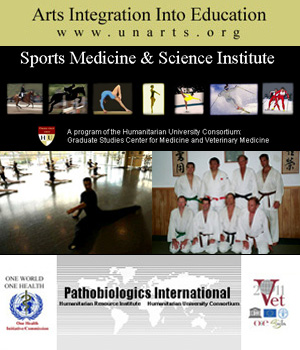
Child Safety, Injury Prevention and
Performance Optimization
Classical ballet training is the most
advanced technical movement mechanics training in the world, providing
the foundation for all styles of dance, sports and Olympic development
programs.
Nothing is more disturbing than teaching an international ballet
development program, with a cross section of U.S. and international
students, with
95 percent unable to stand in a parallel position and execute a simple
plie with correct alignment.
One of the first objectives in classical ballet training is learning
how to stand with correct posture. The parallel position of the feet
encompasses distribution of weight, heel aligned with the center line
of the foot (1st/2nd metatarsal head). As the knees bend in a
simple plie position, [1] alignment is maintained with the knee cap
tracking directly through this center line of the ankle/foot complex
(preparing for eventual work on pointe).
As training progresses, the student eventually learns how to work in
turnout (1st, 2nd, 3rd, 4th, 5th positions), or alignment positions
where
the foot externally rotates, while maintaining correct knee, ankle,
foot
alignment.
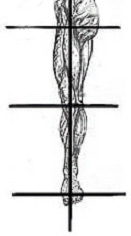
The classical ballet mechanical ideal: heel behind centerline of foot,
knee cap tracking over the center line of ankle and foot. In the
plie position, the hip complex and kneecap must track through
this line. This alignment is maintained through demi-pointe and
in the most advanced training, on pointe.
In Eastern Bloc development programs, a selection process is used to
identify students best suited for participation in dance or sports
(Olympic) development programs. In Romania, pre-gymnastics training
encompasses 6 days a week, 45 minutes per day of classical ballet based
choreography training, to develop fundamental movement mechanics prior
to the introduction of sports specific movement. In the late
90's, Geza Pozar, Romanian National Team coach/choreographer for Nadia
Comăneci [2] shared with me the importance of this work for all
participants in for the USA Gymnastics National Team Coaches Education
Programs.
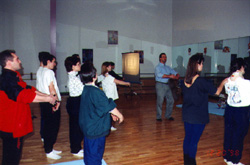
Stephen M. Apatow, [3] Founder, Director of Research and Development
for the Sports Medicine & Science Institute teaching a gymnastics a
coaches development program at the Gymnastics Training Center in
Rochester,
NY. in 1998. Gymnastics coaches in this photo include Maria
Filotova, a member of the 1976 and '80 Soviet Union Olympic teams, and
Sasha
Kourbatov, former member of the Russian international team.
[4]
Here in the United States, all children are allowed to
participate, irregardless of their physical limitations.
We progress directly into sports specific training, while we
skip the fundamental movement mechanics (classical ballet based
choreography training), and don't integrate accentuated flexibility
training to better enable the functional capacity of the
students. The dilemma, there is no time, too many children
in the programs, and it doesn't fit into the business model.
In the classical ballet world, Eastern Bloc teachers, trained at the
worlds top training schools understand the meaning of technically
correct and if such a standard was upheld, that there would be very few
students working in 5th position. In reality, if correct
alignment was the rule, they would be working in a modified 5th
or a 3rd position. But Eastern Bloc ballet and Olympic coaches,
many times remain silent, because these
are unpopular topics.
Excellence vs Mediocrity
The challenge with mainstream classical ballet training, pre-ballet
to professional level, is insufficient classical ballet specific
stretch
and flexibility training, that prepares the students for the demands of
the development program. The consequences of this oversight, is
repetitive movement mechanics that load the spine or extremities with
incorrect alignment. The result being adaptive joint deformation
and many times permanent stabilization.
Can you take a young child and adapt them to a deformed or malaligned
position without pain ? In many cases, yes, at least until the
non-symptomatic stressed alignment progresses into a full blown injury.
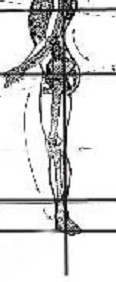
Joint deformation challenges from forced turnout, include
compensatory stabilization in articular development of the foot/ankle
complex, knee complex, hip complex and spine. The entire body is
interconnected, head to toe. Any incorrect alignment variable
causes a compensatory adjustment to accommodate function.
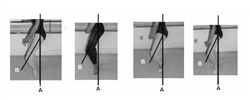
Typical alignment challenges at the barre. Line A represents
the ideal line that a correct foot would track through. The
mechanical ideal would encompasses the knee cap tracking through the
center of the ankle/foot complex or Line A. Line B represents the
true degree of hip turnout possessed by the student, that would require
internal rotation of the foot so that correct parallel knee, ankle,
foot alignment would be maintained in a turned out position.
Orthopedics: The Classical Ballet
Mechanical Ideal
In the field of medicine, including the specialized field of
orthopedics, the topic of correct postural alignment is a missing focus
of study. In the absence of a mechanical postural alignment
ideal, there exists no reference point to address the mechanism of
joint stress and injury. In the
late 80's, Stephen M. Apatow [3] took his studies in sports medicine
and
exercise physiology into the study of classical ballet, as an athlete
training
for international competition in the sports of cross country skiing and
rowing. As a result of this work, he was asked to develop a specialized
program for optimization of the elite ballet dancer preparing for the
Lausanne International Ballet Competition. [4]. Analysis was
based on the mechanical ideal in classical ballet training, correction
of spine and extremity articular variables associated with
stabilization/deformation and then retraining in the fundamentals.
The success of this work yielded immediate results and served as a
starting point for the integration of this work into all levels of the
pedagogical program at Nutmeg Conservatory for the Arts. In the early
90's the Sports Medicine and Science Institute was formed and
biomechanical analysis, correction and retraining programs were
developed for athletes in Olympic and sports development programs that
include professional football, national level gymnastics, wrestling,
martial arts hockey, skiing, figure skating, equestrian rider
development [5] and Armed Forces Development Programs. [6]
At the request of the medical community, this work has been integrated
into orthopedic applications for cases that include entrapment
neuropathies, scoliosis, rheumatoid arthritis, asthma, fibromyalgia,
friedreich ataxia, multiple sclerosis [7] and veterinary cases [8]
(canine, equine):
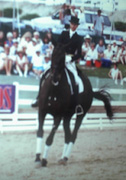
Loma Fowler: Dressage scholarship recipient for rider biomechanical
analysis, correction and retraining. -- BalletEquestria: Rider &
Equine Development Programs. [9]
Today, the Sports Medicine & Science Institute and International
Dancescience Development Program emphasizes the importance of postural
analysis, based on the classical ballet mechanical ideal. Any
deviation from the
correct classical ballet based alignment ideal, corresponds with a
limitation
of potential performance, joint stress and injury. If postural
alignment is neglected, then analysis, diagnosis and treatment, that
targets the mechanism of injury is compromised and contributes to the
widespread overuse of pharmaceuticals and unnecessary surgical
procedures in the treatment of more than 10
million sports injuries each year in the United States.
[10] Typical challenges in ballet include:
Accessory Bone Pain: Aka Accessory Bone
Pain, Painful Accessory Bones, Os Trigonum Syndrome, Os Trigonum,
Accessory Tarsal Navicular. -- Family Practice Notebook. [11]
Education initiatives associated with classical ballet based
biomechanics and accentuated stretch and flexibility need to be
integrated into all dance and sports development programs.
The International Dancescience Development Program advocates
the incorporation of this work into every
technique class and rehearsal, to optimize the progress of every
student
in the classical ballet development program. These same principles
apply
to sports and Olympic development programs.
The following introductory distance education and certification course
was developed for students, parents, dance instructors, physicians and
therapists associated with dance, sports and Olympic development
programs:
For additional information, visit the International Dancescience
Development Program web site at: www.edancescience.org
References:
1. Plie: ABT Dictionary. Url:
www.abt.org/education/dictionary/terms/plie.html
2. Nadia Comăneci: Wickpedia. Url:
www.en.wikipedia.org/wiki/Nadia_Com%C4%83neci
3. Stephen M. Apatow: Sports Medicine & Science Institute
and International Dancescience Development Program. Url: www.apatow.org
4. 1998 Gymnastics Coaches Workshop: GTC Gymnastics Training
Center in Rochester, NY. Url:
www.esportsmedicine.org/sportscience/gtcworkshop.html
4. Regimen Changes Body: Linda Boultinghouse, Register Citizen,
Torrington, Connecticut. Url: www.esportsmedicine.org/rcb.html
5. JudoSport International: Url: www.judosport.org
6. Armed Forces Development Programs: See: Special Protective
Forces for Humanitarian Operations. Url:
www.unarts.org/H-II/ref/spf_deopressoliber.html
7. Sports Medicine & Science Institute: Url: www.esportsmedicine.org
8. Pathobiologics International: Url: www.pathobiologics.org
9. BalletEquestria: Rider & Equine Development Programs.
Url: www.balletequestria.org
10. The Merck Manual - Home Edition,
Sec. 5, Ch. 57, Sports Injuries: Url:
www.merckmanuals.com/mmanual_home/sec5/57.htm
11. Accessory Bone Pain: Family Practice Notebook.Url:
www.fpnotebook.com/Ortho/Foot/AcsryBnPn.htm
|
.
..
Copyright © 2011 Sports Medicine
& Science Institute All rights reserved
|